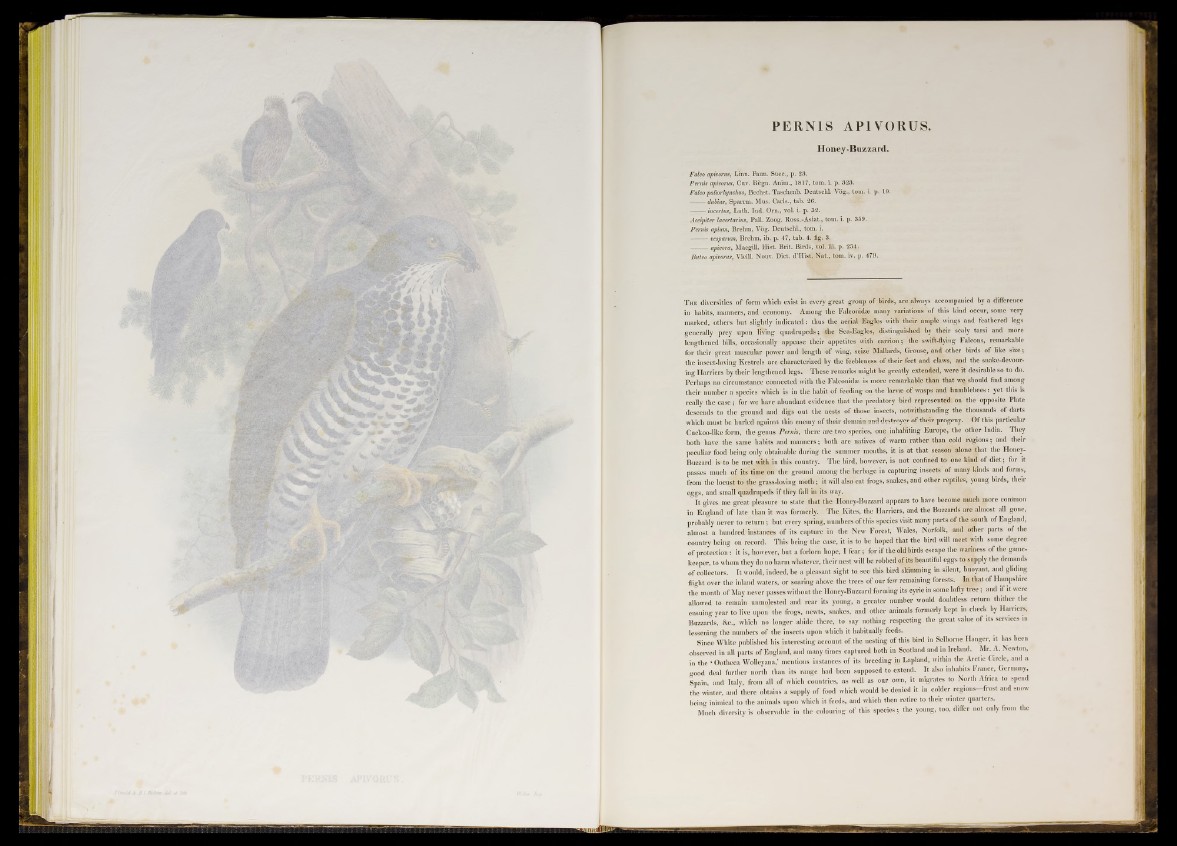
■ ; '- - " I § £ ^ ■ * ■-*'* mstwr-r- — ■
PERN1S AP1VORUS .
Honey-Buzzard.
Falco apivorus, Linn. Faun. Suec., p. 23.
Pernis apivorus, Cuv. Rfegn. Anim., 1817, tom. i. p. 323.
Falco poliorhynchus, Bechst. Taschenb. Deutscbl. Vog., tom. i. p. 19.
dubius, Sparrm. Mus. Carls., tab. 26.
incertus, Lath. Ind. Ora., vol. i. p. 32.
Accipiter lacertarius, Pall. Zoog. Ross.-Asiat., tom. i. p. 359.
Pernis apitm, Brehm, Yog. Deutschl., tom. i.
vesparum, Brehm, ib. p. 47, tab. 4. fig. 3.
apivora, Macgill. Hist. Brit. Birds, vol. iii. p. 254.
Buteo apivorus, Vieill. Nouv. Diet. d’Hist, Nat., tom. iv. p. 479.
T h e diversities o f form which exist in every great group of birds, are always accompanied by a difference
in habits, manners, and economy. Among the Falconidae many variations of this kind occur, some very
marked, others but slightly indicated: thus the aerial Eagles with their- ample wings and feathered legs
generally prey upon living quadrupeds; the Sea-Eagles, distinguished by their scaly tarsi and more
lengthened bills, occasionally appease their appetites with carrio n ; the swift-flying Falcons, remarkable
for their great muscular power and length of wing, seize Mallards, Grouse, and other birds of like size;
the insect-loving Kestrels are characterized by the feebleness o f their feet and claws, and the snake-devouring
H arriers by their lengthened legs. These remarks might be greatly extended, were it desirable so to do.
Perhaps no circumstance connected with the Falconidae is more remarkable than that we should find among
their number a species which is in the habit of feeding on the larvae o f wasps and humblebees: yet this is
really the c a se ; for we have abundant evidence that the predatory bird represented; on the opposite Plate
descends to the ground and digs out the nests o f those insects, notwithstanding the thousands of darts
which must be hurled against this enemy of their domain and destroyer o f their progeny. O f this particular
Cuckoo-like form, the genus Pernis, there are two species, one inhabiting Europe, the other India. They
both have the same habits and manners; both are natives of warm rather than cold regions; and their
peculiar food being only obtainable during the summer months, it is at that season alone that the Honey-
Buzzard is to be met with in this country. The bird, however, is not confined to one kind of d iet; for it
passes much o f its time on the ground among the herbage in capturing insects of many kinds and forms,
from the locust to the grass-loving moth; it will also eat frogs, snakes, and other reptiles, young birds, their
eggs, and small quadrupeds if they fall in its way.
I t gives me great pleasure to state that the Honey-Buzzard appears to have become much more common
in England o f late than it was formerly. The Kites, the Harriers, and the Buzzards are almost all gone,
probably never to r e tu rn ; but every spring, numbers o f this species visit many parts of the south of England,
almost a hundred instances of its capture in the New Forest, Wales, Norfolk, and other parts o f the
country being on record. This being the case, it is to be hoped that the bird will meet with some degree
o f protection: it is, however, but a forlorn hope, I f e a r ; for if the old birds escape the wariness of the gamekeeper,
to whom they do no harm whatever, their nest will be robbed of its beautiful eggs to supply the demands
of collectors. I t would, indeed, be a pleasant sight to. see this bird skimming in silent, buoyant, and gliding
flight over the inland waters, or soaring above the trees o f our few remaining forests. In that of Hampshire
the month of May never passes without the Honey-Buzzard forming its eyrie in some lofty t r e e ; and if it were
allowed to remain unmolested and rear its young, a greater number would doubtless return thither the
ensuing year to live upon the frogs, newts, snakes, and other animals formerly kept in check by Harriers,
Buzzards, &c., which no longer abide there, to say nothing respecting the great value o f its services m
lessening the numbers o f the insects upon which it habitually feeds.
Since White published his interesting account of.the nesting o f this bird in Selborne Hanger, it has been
observed in all parts of England, and many times captured both in Scotland and in Ireland. Mr. A. Newton,
in the ‘ Ootheca Wolleyana,’ mentions instances of its breeding in Lapland, within the Arctic Circle, and a
good deal further north than its range had been supposed to extend. I t also inhabits France, Germany,
Spain, and Italy, from all of which countries, as well as our own, it migrates to North Africa to spend
the winter, and there obtains a supply of food which would be denied it in c o l d e r regions—frost and snow
being inimical to the animals upon which it feeds, and which then retire to their winter quarters.
Mnch diversity is observable in the colouring o f this species; the young, too, differ not only from the